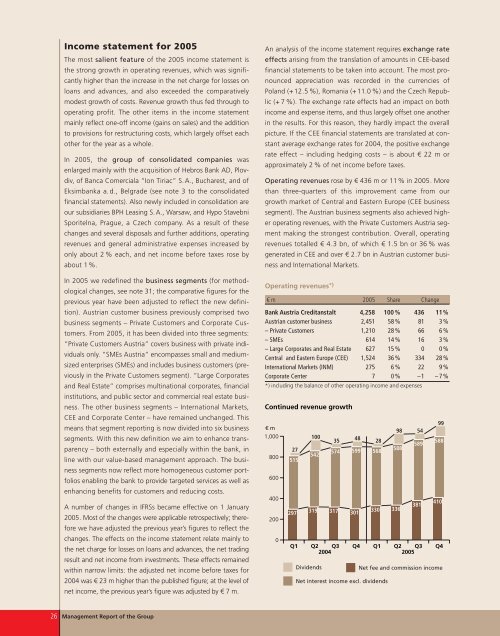team spirit - Bankier.pl
team spirit - Bankier.pl
team spirit - Bankier.pl
Create successful ePaper yourself
Turn your PDF publications into a flip-book with our unique Google optimized e-Paper software.
Income statement for 2005<br />
The most salient feature of the 2005 income statement is<br />
the strong growth in operating revenues, which was significantly<br />
higher than the increase in the net charge for losses on<br />
loans and advances, and also exceeded the comparatively<br />
modest growth of costs. Revenue growth thus fed through to<br />
operating profit. The other items in the income statement<br />
mainly reflect one-off income (gains on sales) and the addition<br />
to provisions for restructuring costs, which largely offset each<br />
other for the year as a whole.<br />
In 2005, the group of consolidated companies was<br />
enlarged mainly with the acquisition of Hebros Bank AD, Plovdiv,<br />
of Banca Comerciala “Ion Tiriac” S.A., Bucharest, and of<br />
Eksimbanka a.d., Belgrade (see note 3 to the consolidated<br />
financial statements). Also newly included in consolidation are<br />
our subsidiaries BPH Leasing S.A., Warsaw, and Hypo Stavebni<br />
Sporitelna, Prague, a Czech company. As a result of these<br />
changes and several disposals and further additions, operating<br />
revenues and general administrative expenses increased by<br />
only about 2 % each, and net income before taxes rose by<br />
about 1%.<br />
In 2005 we redefined the business segments (for methodological<br />
changes, see note 31; the comparative figures for the<br />
previous year have been adjusted to reflect the new definition).<br />
Austrian customer business previously comprised two<br />
business segments – Private Customers and Corporate Customers.<br />
From 2005, it has been divided into three segments:<br />
“Private Customers Austria” covers business with private individuals<br />
only. “SMEs Austria” encompasses small and mediumsized<br />
enterprises (SMEs) and includes business customers (previously<br />
in the Private Customers segment). “Large Corporates<br />
and Real Estate” comprises multinational corporates, financial<br />
institutions, and public sector and commercial real estate business.<br />
The other business segments – International Markets,<br />
CEE and Corporate Center – have remained unchanged. This<br />
means that segment reporting is now divided into six business<br />
segments. With this new definition we aim to enhance transparency<br />
– both externally and especially within the bank, in<br />
line with our value-based management approach. The business<br />
segments now reflect more homogeneous customer portfolios<br />
enabling the bank to provide targeted services as well as<br />
enhancing benefits for customers and reducing costs.<br />
A number of changes in IFRSs became effective on 1 January<br />
2005. Most of the changes were ap<strong>pl</strong>icable retrospectively; therefore<br />
we have adjusted the previous year’s figures to reflect the<br />
changes. The effects on the income statement relate mainly to<br />
the net charge for losses on loans and advances, the net trading<br />
result and net income from investments. These effects remained<br />
within narrow limits: the adjusted net income before taxes for<br />
2004 was € 23 m higher than the published figure; at the level of<br />
net income, the previous year’s figure was adjusted by € 7 m.<br />
26 Management Report of the Group<br />
An analysis of the income statement requires exchange rate<br />
effects arising from the translation of amounts in CEE-based<br />
financial statements to be taken into account. The most pronounced<br />
appreciation was recorded in the currencies of<br />
Poland (+12.5 %), Romania (+11.0 %) and the Czech Republic<br />
(+ 7 %). The exchange rate effects had an impact on both<br />
income and expense items, and thus largely offset one another<br />
in the results. For this reason, they hardly impact the overall<br />
picture. If the CEE financial statements are translated at constant<br />
average exchange rates for 2004, the positive exchange<br />
rate effect – including hedging costs – is about € 22 m or<br />
approximately 2 % of net income before taxes.<br />
Operating revenues rose by € 436 m or 11% in 2005. More<br />
than three-quarters of this improvement came from our<br />
growth market of Central and Eastern Europe (CEE business<br />
segment). The Austrian business segments also achieved higher<br />
operating revenues, with the Private Customers Austria segment<br />
making the strongest contribution. Overall, operating<br />
revenues totalled € 4.3 bn, of which € 1.5 bn or 36 % was<br />
generated in CEE and over € 2.7 bn in Austrian customer business<br />
and International Markets.<br />
Operating revenues *)<br />
€ m 2005 Share Change<br />
Bank Austria Creditanstalt 4,258 100 % 436 11%<br />
Austrian customer business 2,451 58 % 81 3 %<br />
– Private Customers 1,210 28 % 66 6 %<br />
– SMEs 614 14 % 16 3 %<br />
– Large Corporates and Real Estate 627 15 % 0 0 %<br />
Central and Eastern Europe (CEE) 1,524 36 % 334 28 %<br />
International Markets (INM) 275 6 % 22 9 %<br />
Corporate Center 7 0 % –1 – 7 %<br />
*) including the balance of other operating income and expenses<br />
Continued revenue growth<br />
€ m<br />
1,000<br />
800<br />
600<br />
400<br />
200<br />
0<br />
27<br />
515<br />
297<br />
100<br />
542<br />
319<br />
35<br />
574<br />
317<br />
48<br />
599<br />
301<br />
568<br />
330<br />
588<br />
336<br />
589<br />
381<br />
588<br />
410<br />
Q1 Q2 Q3 Q4 Q1 Q2 Q3 Q4<br />
2004 2005<br />
Dividends<br />
28<br />
Net interest income excl. dividends<br />
98<br />
54<br />
99<br />
Net fee and commission income
















